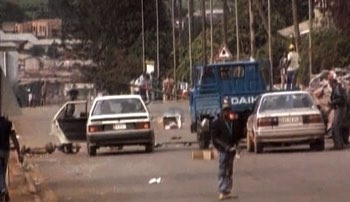Encounters with conflict and peace
How do you start a genocide?
On the morning of April 7th 1994, orders went out across Rwanda. The interahamwe militia set up roadblocks around Kigali, opposition leaders were murdered and soldiers and militia were sent throughout the country to carry out a wave of killings.

The killings spread throughout Rwanda, though at different speed in different areas. In some places, the militia were transported in from other regions and, working from carefully prepared lists, swept through neighbourhoods targeting Tutsis and moderate Hutus. But Rwanda is a small country, and in many places there was no need for lists.

"Rwanda, famous land of a thousand hills, is above all a land of one vast village. Four out of five Rwandan families live in the countryside…. Even Kigali seems less like a capital city than a collection of villages linked by little valleys and tracts of open ground.
After the genocide, many foreigners wondered how the huge number of Hutu killers recognized their Tutsi victims in the upheaval of the massacres, since Rwandans of both ethnic groups speak the same language with no distinctive differences, live in the same places, and are not always physically recognizable by distinctive characteristics.
The answer is simple. The killers did not have to pick out their victims: they knew them personally. Everyone knows everything in a village."
From A time for machetes. The killers speak by Jean Hatzfeld
![]()
Looking for safe places
Tutsis spontaneously moved to where they thought they would be safest - schools, churches and villages with a high Tutsi population. Government radio also told them to take refuge in these places, but in reality they were being rounded up. It was much easier to kill a large group trapped in one area than to chase individuals through villages, forests and marshes.
Where they resisted, the Rwandan army was trucked in with machine guns and grenades. Within two weeks, perhaps a quarter of a million people had been slaughtered.

"In the land of philosophy that was Germany, genocide was intended to purify being and thought. In the rural land of Rwanda, genocide was meant to purify the earth, to cleanse it of its cockroach farmers. The Tutsi genocide was thus both a neighbourhood genocide and an agricultural genocide. And in spite of its summary organization and archaic tools, it was outstandingly effective.
Its yield proved distinctly superior to that of the Jewish and Gypsy genocide, since about 800,000 Tutsis were killed in twelve weeks. In 1942, at the height of the shootings and deportations, the Nazi regime and its zealous administration, its chemical industry, its army and police, equipped with sophisticated material and industrial techniques (heavy machine guns, railway infrastructure, index files, carbon monoxide gas trucks, Zyklon B gas chambers…) never attained so murderous a performance level anywhere in Germany or its fifteen occupied countries." (Jean Hatzfeld)
< previous page | next page >
In this section
STARTING A GENOCIDE
Whose idea was it?
How did it start?
The foreigners are leaving
Hate radio
DETAILS
Roadblocks
The little things
INSIGHT
A simple plan
This new job
A strangeness of mind
Personalities
A good man
FOCUS ON THE BUGESERA
The Bugesera
Ntarama church massacre
A day in the marshes
MZUNGUS
The role of the west
Two French missionaries
A journalist's story
THE END OF THE GENOCIDE
The refugee crisis
A country with nobody home

Whose idea was it?
How did it start?
The foreigners are leaving
Hate radio
DETAILS
Roadblocks
The little things
INSIGHT
A simple plan
This new job
A strangeness of mind
Personalities
A good man
FOCUS ON THE BUGESERA
The Bugesera
Ntarama church massacre
A day in the marshes
MZUNGUS
The role of the west
Two French missionaries
A journalist's story
THE END OF THE GENOCIDE
The refugee crisis
A country with nobody home

